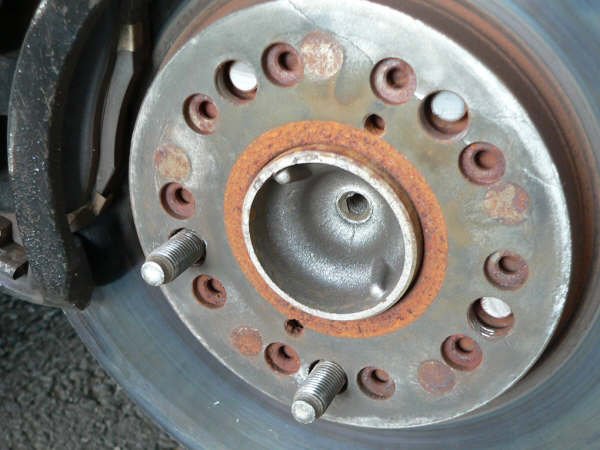I made an alarming discovery last week when I lost one of the center caps from the Volk wheels on my Supra; I didn't have hubcentric adaptors on all 4 wheels!
For those who are not familiar with these things, here's a bit of preliminary background. All wheels for late model cars must be centered on the wheel "hub", which is a raised lip (about 1/4" to 3/8" high on my Supra) that protrudes out past the disc brake rotor. On Supras, Lexi, and most other Toyota cars, this lip is 60.1mm outside diameter.
Now most aftermarket wheels have an interior hub that "sort of" matches up to this lip, however in order to fit as many applications as possible, this interior dimension may be larger than the 60.1mm of our Toyota/Lexus product. In fact, my Volk F-Zero Challenge wheels have an interior hub diameter of 73.1mm. So I've got 13mm of "slop" between my wheels and my hubs.
So what? That's why we have conical lug nuts, so that the wheel will "center" itself evenly on the lugs, right? Then once the wheel is torqued to spec, the "friction" of the wheel hub surface on the car hub surface will keep it in place, right? Wrong. This is called "lug centric" mounting, which is an older method that is no longer suitable with the smaller diameter lugs used in today's imported cars.
So, back to my 13mm of slop - there are "Hubcentric Adaptors" available which adapt wheels to various size wheel hubs and "take up" this slop. In my case, after talking with Mackin (the US reps for Volk/Rays) they recommended a polyurethene hubcentric adaptor which was a perfect fit into the tapered face and 73.1mm bore of my Volk wheels, plus did not protrude out past the surface of the wheel. I installed these this morning as shown in the following photos.
I also discovered that I did have hubcentric adaptors on my two front wheels, however these little aluminum rings (73.1mm OD x 60.1mm ID) had wedged themselves deeper into the wheels' bore and were no longer providing a good seating surface for the Supra's hub.
Conclusions:
1. If you're running aftermarket wheels, be sure that you're running hubcentric adaptors that fit both your car and your wheels.
2. Make sure the adaptors are actually providing a seating surface for both the wheel and the car's hub.
Peter Scott has an excellent article on hubcentric adaptors (spigot rings) here: http://planetsoarer.com/offset/studs.htm
For those who are not familiar with these things, here's a bit of preliminary background. All wheels for late model cars must be centered on the wheel "hub", which is a raised lip (about 1/4" to 3/8" high on my Supra) that protrudes out past the disc brake rotor. On Supras, Lexi, and most other Toyota cars, this lip is 60.1mm outside diameter.
Now most aftermarket wheels have an interior hub that "sort of" matches up to this lip, however in order to fit as many applications as possible, this interior dimension may be larger than the 60.1mm of our Toyota/Lexus product. In fact, my Volk F-Zero Challenge wheels have an interior hub diameter of 73.1mm. So I've got 13mm of "slop" between my wheels and my hubs.
So what? That's why we have conical lug nuts, so that the wheel will "center" itself evenly on the lugs, right? Then once the wheel is torqued to spec, the "friction" of the wheel hub surface on the car hub surface will keep it in place, right? Wrong. This is called "lug centric" mounting, which is an older method that is no longer suitable with the smaller diameter lugs used in today's imported cars.
So, back to my 13mm of slop - there are "Hubcentric Adaptors" available which adapt wheels to various size wheel hubs and "take up" this slop. In my case, after talking with Mackin (the US reps for Volk/Rays) they recommended a polyurethene hubcentric adaptor which was a perfect fit into the tapered face and 73.1mm bore of my Volk wheels, plus did not protrude out past the surface of the wheel. I installed these this morning as shown in the following photos.
I also discovered that I did have hubcentric adaptors on my two front wheels, however these little aluminum rings (73.1mm OD x 60.1mm ID) had wedged themselves deeper into the wheels' bore and were no longer providing a good seating surface for the Supra's hub.
Conclusions:
1. If you're running aftermarket wheels, be sure that you're running hubcentric adaptors that fit both your car and your wheels.
2. Make sure the adaptors are actually providing a seating surface for both the wheel and the car's hub.
Peter Scott has an excellent article on hubcentric adaptors (spigot rings) here: http://planetsoarer.com/offset/studs.htm





